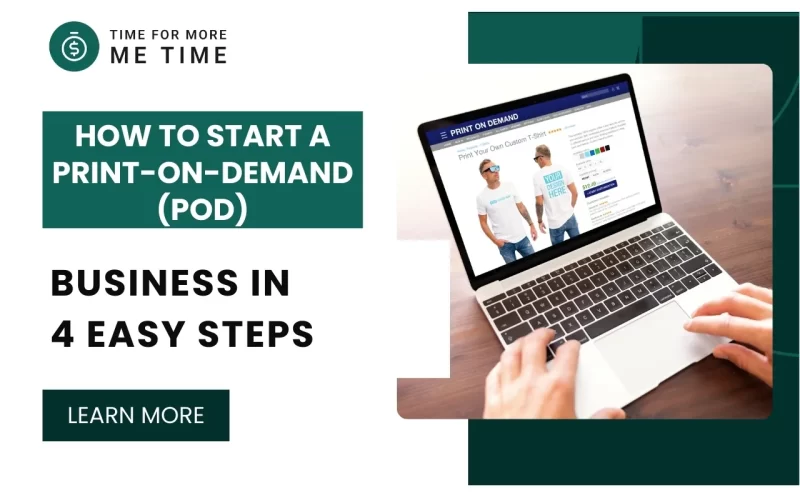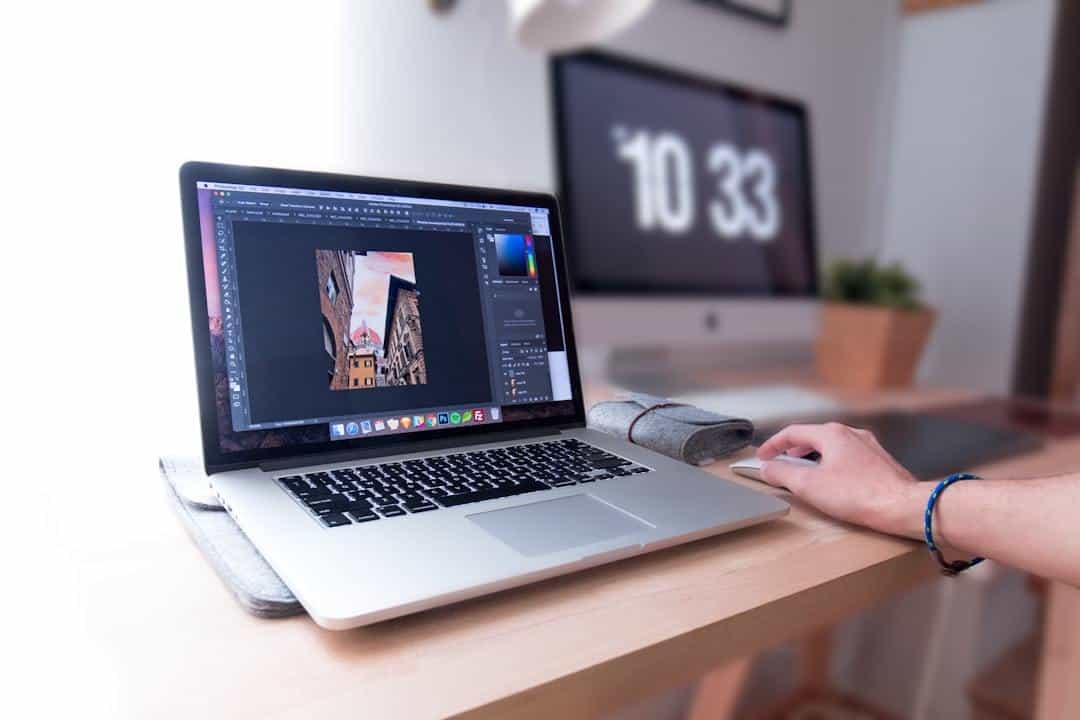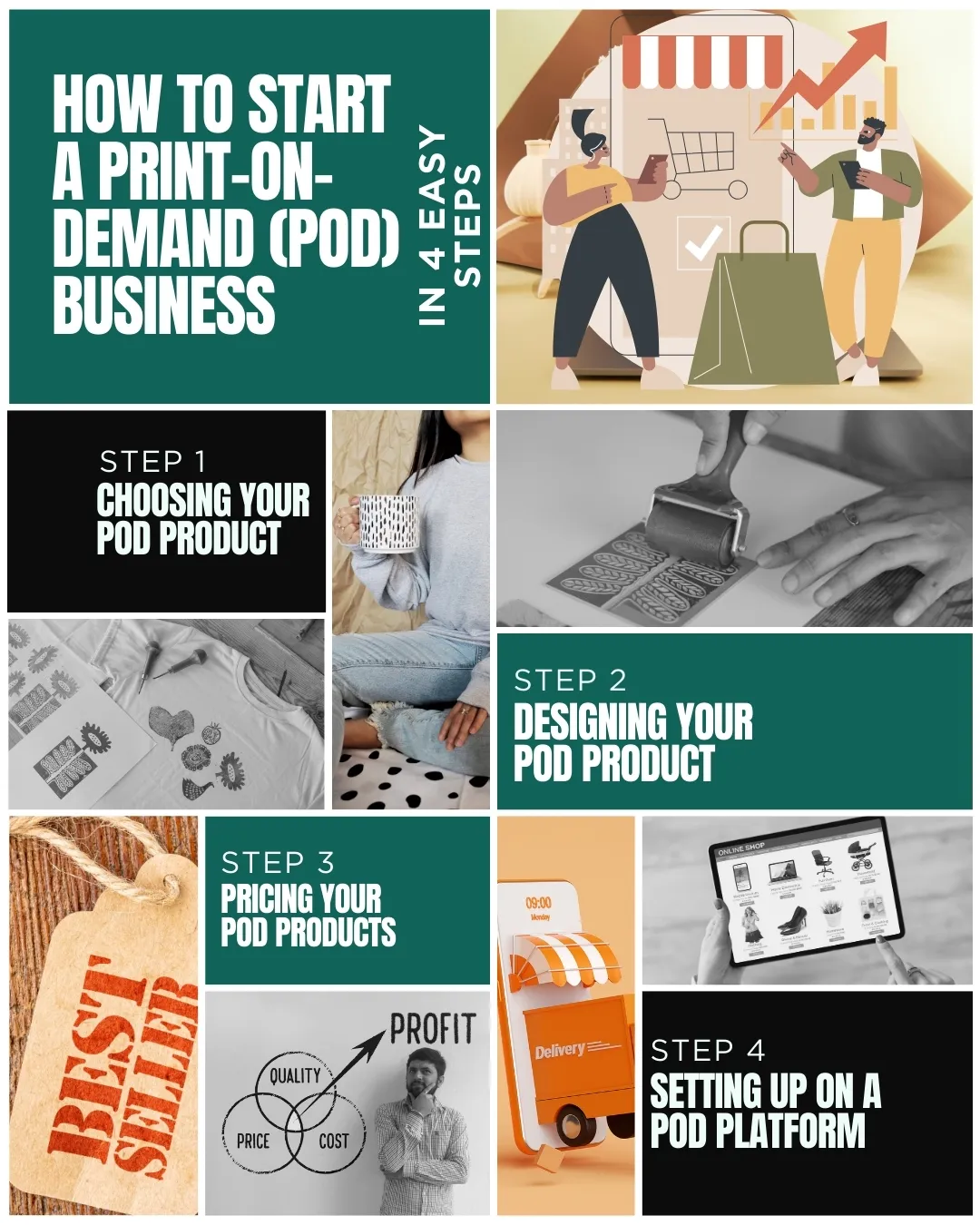
As more people explore creative ways to start a side hustle, you might be thinking about launching your own business. If you’re looking for a low-risk, flexible way to sell custom products online, print-on-demand (POD) could be the perfect fit.
With POD, you don’t need to keep inventory. Instead, products are created only when a customer places an order—making it a hassle-free way to sell. A third-party POD service handles manufacturing, printing, and shipping. And you? You get to focus on running your online store and building your brand.
It’s a simple setup with big benefits. You’ll enjoy low startup costs, a wide range of customizable products, and zero need for storage space. But it’s not all smooth sailing—expect lower profit margins, less control over fulfillment, and plenty of competition.
If you’re interested, let’s get started!
1. Choosing Your POD Product
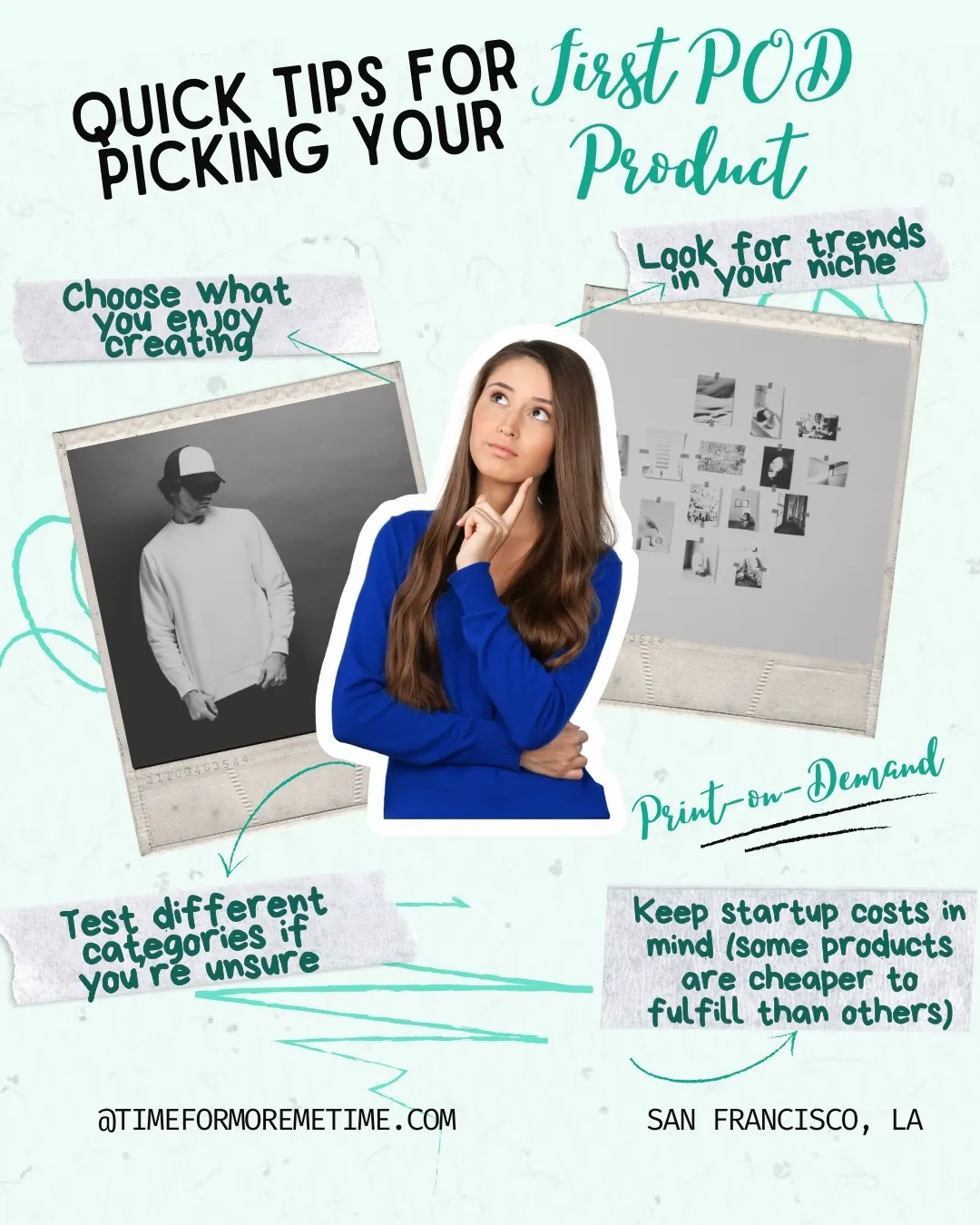
When starting a print-on-demand business, the first step is choosing what products to sell. Your interests and hobbies will likely shape your selection. Think about what excites you—what you’d enjoy designing and sharing with the world.
Here are some popular product categories to consider:
- Apparel: Clothing is the go-to choice for POD, and for good reason. Fashion is ever-evolving, and people always need clothes. Some top-selling POD apparel items include printed hoodies, personalized yoga pants, and custom socks.
- Home Décor: If fashion isn’t your thing, home décor is another thriving market. Wall art has been especially popular, particularly during the COVID pandemic when people were redesigning their spaces. Other bestsellers include printed cushions, decorative towels, and framed illustrations.
- Accessories: If neither of the above interests you, accessories offer a wide range of possibilities. Many items can be customized through POD, from mugs, tote bags, and water bottles to fanny packs, caps, and even belts.
No matter which category you choose, the key is to pick something you’re passionate about—because when you enjoy what you create, it shows!
2. Designing Your POD Product
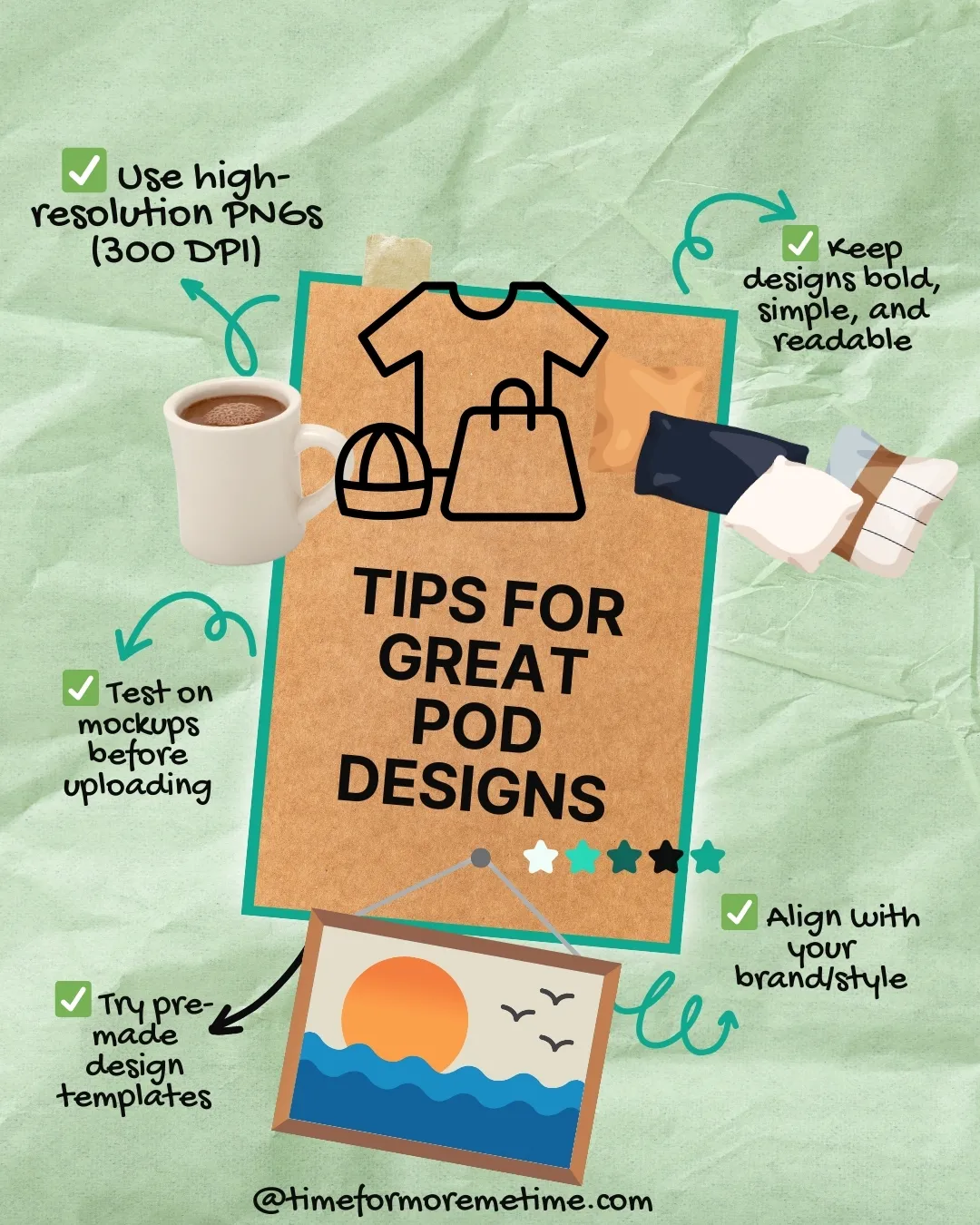
After choosing the type of product you want to focus on, the next step is to create designs. This is critical because your design will set you apart from the competition and determine whether people want to buy your products.
Worried that you’re not a designer? No problem! The great news is that anyone can create stunning, print-ready designs using beginner-friendly graphic design software. Here’s how:
- Choose Your Design Software: There are plenty of tools to help you create professional-looking designs. Paid options like Photoshop or Illustrator offer advanced features, but if you’re just starting, free alternatives like Canva, Pixlr, or Photopea work great. Canva provides ready-made templates for various products, while Pixlr and Photopea give you full creative control. Whatever you choose, always save your files as PSD or transparent PNG and use high-resolution settings to ensure crisp prints.
- Check Design Specifications: Not all designs fit every product the same way. An image sized for an 11-ounce coffee mug might need adjustments to print correctly on a tote bag or t-shirt. Before uploading your designs, double-check the printing specifications of your print provider to avoid misalignment or quality issues. Taking a little extra time here ensures your customers receive a flawless product.
- Use Pre-Made Design Templates: Short on time or not confident in your design skills? Pre-made templates can help! Many online platforms allow artists to sell their designs as ready-to-use templates. While you won’t own exclusive rights to them, it’s a quick and easy way to stock your store with high-quality designs. Websites like Designious and Tshirt-Factory offer a range of print-ready templates, typically priced between $7 and $25 per design.
No matter which route you take, the key is to create eye-catching designs that customers will love. With the right tools and approach, you’ll have a unique and professional-looking POD product in no time!
Over time, you might even develop real skills in graphic design. As you create more products, you’ll learn what works, sharpen your style, and build the confidence to design with purpose. You don’t need to be an expert now—just start simple and grow as you go.
3. Pricing Your POD Products
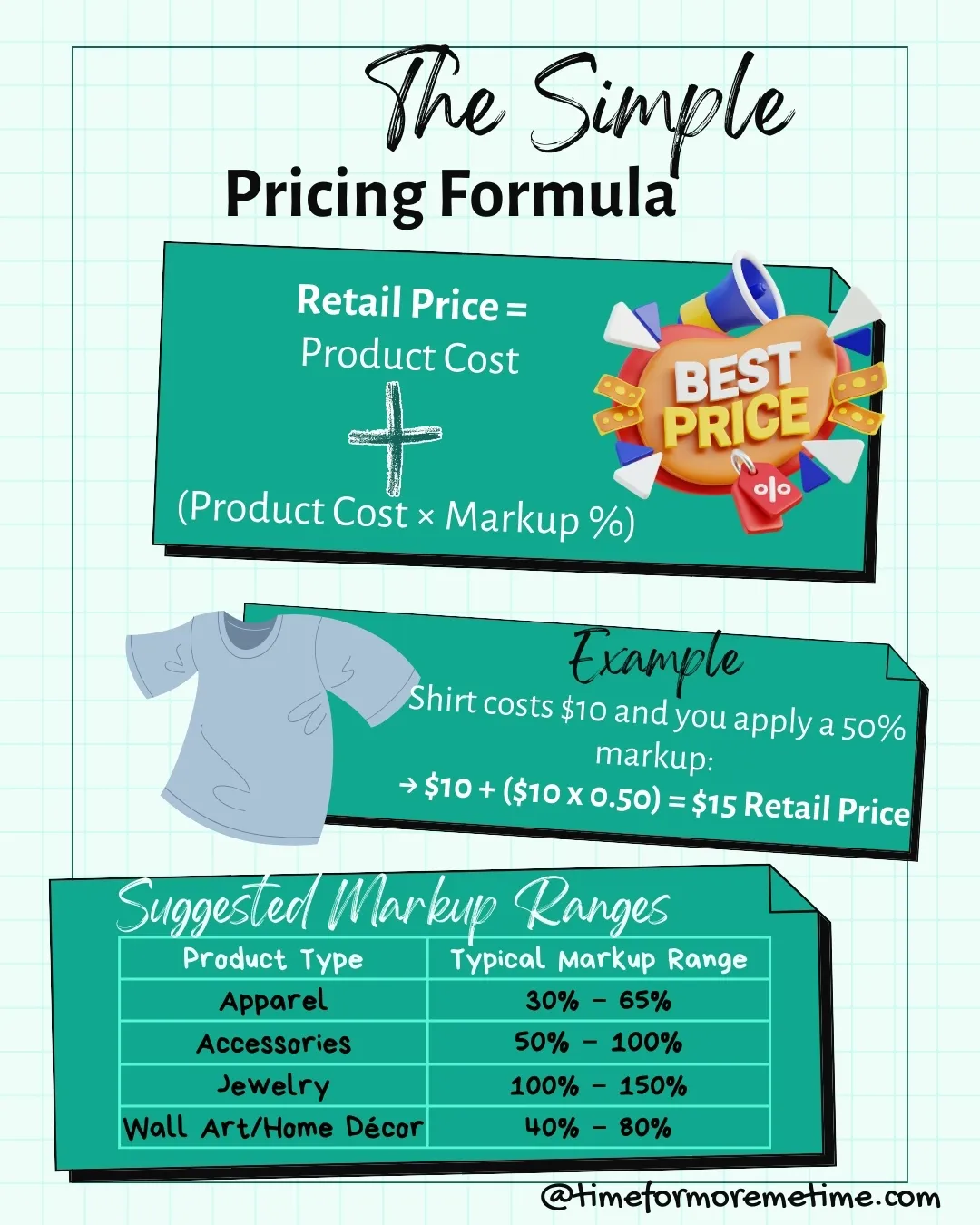
Once your design is ready, it’s time to set your prices. This can be challenging, even for seasoned business owners. You must strike a balance between profitability and affordability.
Another important consideration is incurring various third-party expenses that can drive up the price of your product. That’s normal since you’re only responsible for the design and the customer-facing store.
To begin pricing your POD products, it’s essential to understand your expenses. Before setting prices, you need a clear breakdown of your costs.
Your retail price is determined by adding your desired profit margin to your total expenses. Here’s what to consider:
- Base Product Cost: This is the amount your supplier charges for the item.
- Production and Shipping Fees: These costs can vary based on your location and where your customers reside.
- Additional Costs: Don’t forget to factor in marketing expenses, platform fees, and any potential discounts you may offer.
By adding up these expenses, you’ll arrive at your total product cost, which serves as the foundation for setting your retail price.
Next, utilize a straightforward pricing formula. A simple formula can be expressed as:
Retail Price = Product Cost + (Product Cost × Markup Percentage).
For example, if your POD product costs $10 and you desire a 50% markup, your markup would be $5 (calculated as $10 x 50%). Adding this markup to the product cost results in a retail price of $15 ($10 + $5).
Keep in mind that markup percentages can vary by product type, so it’s crucial to research your niche. For instance, apparel typically has a markup of 30%–65%, while jewelry and accessories may range from 100%–150%.
Lastly, while cost-plus pricing is a straightforward approach for beginners, it’s important to remember that it doesn’t account for market demand or competitor pricing.
As you gain experience, refine your strategy. Know how to analyze competitor prices and experiment with different price points.
4. Setting Up On A POD Platform

Now that you have an idea of the POD products you want to sell and their prices, the next step is to set up shop. Typically, it’s recommended that you set up an eCommerce store yourself or sell on social media.
However, if you’re not tech-savvy or not active on social media, you can take advantage of eCommerce platforms and services that can help you. Here are some options:
- Shopify: Shopify makes it easy to integrate print-on-demand products into a visually appealing website. With a basic plan starting at $39 per month, you can personalize your store’s appearance and access built-in SEO tools, marketing resources, and customer support. Just be ready to invest in advertising if you’re not already established.
- Etsy: As a well-known marketplace for artists and collectors, Etsy offers less competition and a supportive community. Creating an account is free, but listing fees apply as you add products. With higher organic traffic, you may spend less on advertising, making it ideal for reaching a diverse customer base with custom print-on-demand items.
- Redbubble: Founded in 2006, Redbubble hosts over 700,000 artists and designers. They offer a wide range of print-on-demand products and provide worldwide shipping, often with free shipping options. Redbubble also features an associates program and attracts around 5.3 million monthly users.
- Printful: A leading name in the industry, Printful is popular for its extensive product selection and seamless integration with various e-commerce platforms. They handle printing and shipping, allowing you to focus on growing your business.
- Printify: Ideal for beginners, Printify offers a free plan that lets you sell up to 25 products per month. With numerous print providers, you can find the best prices and quality for your items. It’s also a great platform for selling digital products.
- Gooten: If you want a platform with global reach, Gooten has production partners worldwide, ensuring quick and affordable delivery. Their user-friendly design tool makes creating products a breeze.
- Society6: Another popular marketplace, Society6 manages everything from printing to shipping. They offer a vast selection of products, including art prints, phone cases, and shower curtains.
These are just a few of the many print-on-demand platforms available. The best choice for you will depend on your specific needs and goals, but this overview should provide a solid starting point for your research.
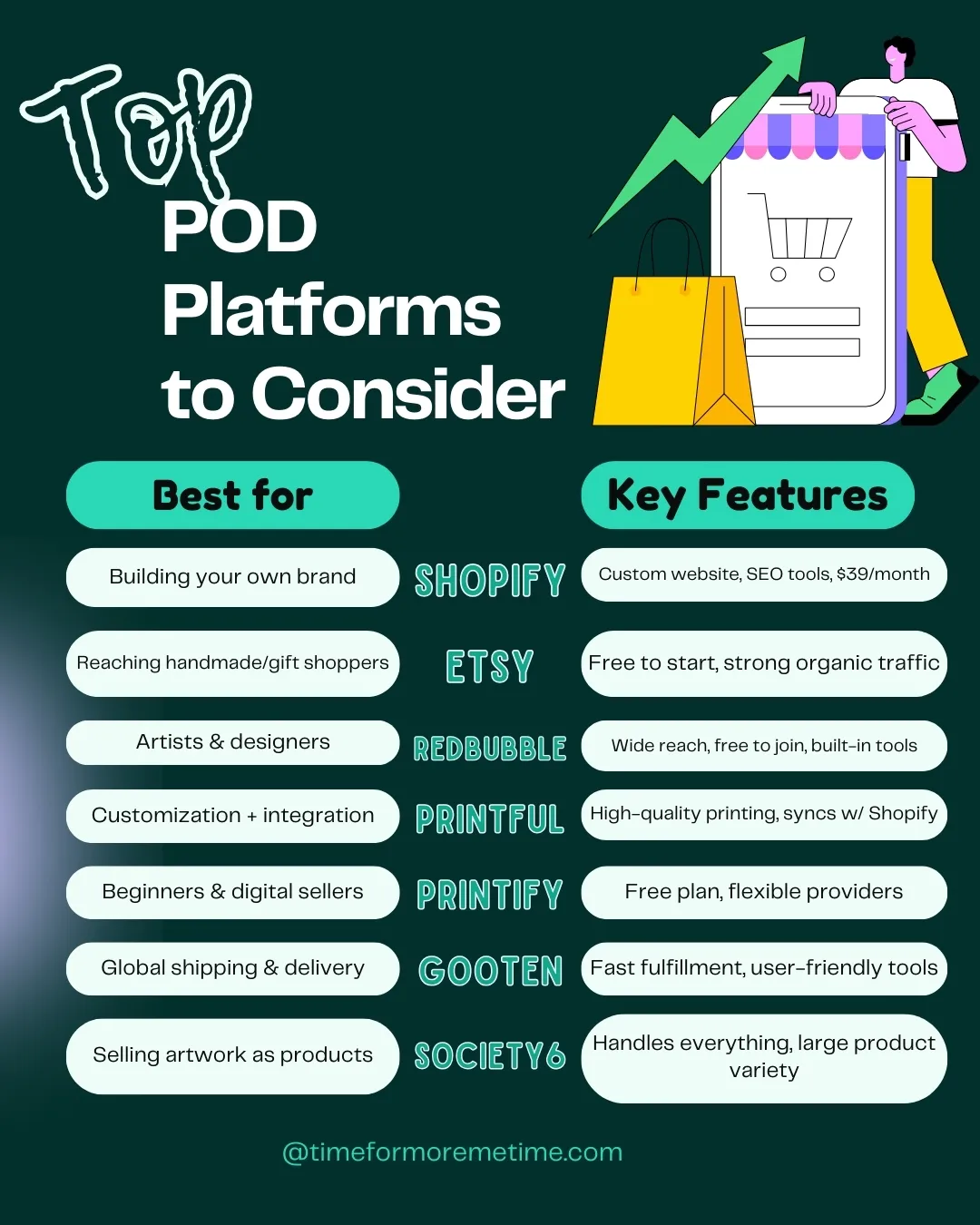
FAQs
If this short guide left some of your questions unanswered, you might find the answers here in this section.
How long does it take to start a POD business from scratch?
Starting a print-on-demand business can take anywhere from a few days to a few weeks, depending on how quickly you set up your store and create your designs. If you already have design ideas and a chosen platform (like Shopify, Etsy, or Redbubble), you can launch within a weekend.
However, if you need time to research products, experiment with design tools, or build a brand identity, the process may take a few weeks. Not a big issue, though.
The timeline also depends on how much effort you put into marketing and branding before launch. Setting up a store is the easy part, but gaining traction and making sales takes time.
Plan your pricing strategy, optimize your product listings, and have a marketing plan ready. That way, you’ll be in a much better position to attract customers quickly.
Do I need a business license to sell POD products?
In most cases, you don’t need a business license to start selling POD products, especially if you’re operating as a sole proprietor. Many platforms like Etsy, Shopify, and Redbubble allow individuals to sell without formal registration.
However, as your business grows, you need to consider licensing. You may need to register it for tax purposes, especially if you reach a certain income threshold in your country or state.
If you plan to create a brand and sell under a business name, registering as an LLC or another business entity can offer legal protection and tax benefits. Additionally, depending on your location, you might need a sales tax permit if you’re required to collect taxes from customers.
It’s always a good idea to check local regulations or consult a professional for legal and tax guidance. Doing so helps you avoid liabilities in the long run.
Can I run a POD business while working a full-time job?
Yes! One of the biggest advantages of a POD business is that it can be run as a side hustle while working a full-time job.
Since you don’t have to manage inventory, handle shipping, or deal with manufacturing, most of your tasks will involve designing, marketing, and managing customer interactions—all of which can be done in your spare time.
Many successful POD sellers start part-time and scale their businesses gradually. And that’s what I aim, too!
To make it manageable, automate as much as possible using POD platforms that integrate with eCommerce sites and schedule social media or ad campaigns in advance.
Dedicate a few hours each week to optimizing your store, analyzing sales data, and improving marketing strategies. Over time, if your business grows significantly, you can decide whether to transition into it full-time.
Conclusion
For budding entrepreneurs and seasoned sellers alike, launching a successful print-on-demand business is well within reach in today’s eCommerce landscape.
The low startup costs, minimal inventory management, and flexibility make it an attractive option for anyone looking to turn creativity into income. That means anyone can start this business.
Of course, consider choosing the right niche, offering unique and high-quality designs, and selecting the best platform that aligns with your business goals. With dedication and the right approach, POD can be a lucrative and enjoyable venture.
Creativity is a major factor, but marketing is just as crucial. Even the best designs won’t sell if people don’t know they exist.
A solid marketing strategy—leveraging social media, paid ads, SEO, and email campaigns—can significantly increase your visibility and sales.
Anyway, there’s a lot more to say, but let’s end with that. If you want to learn more about this kind of topics, be sure to follow my site, my social media pages, and my YouTube channel! Thanks!
